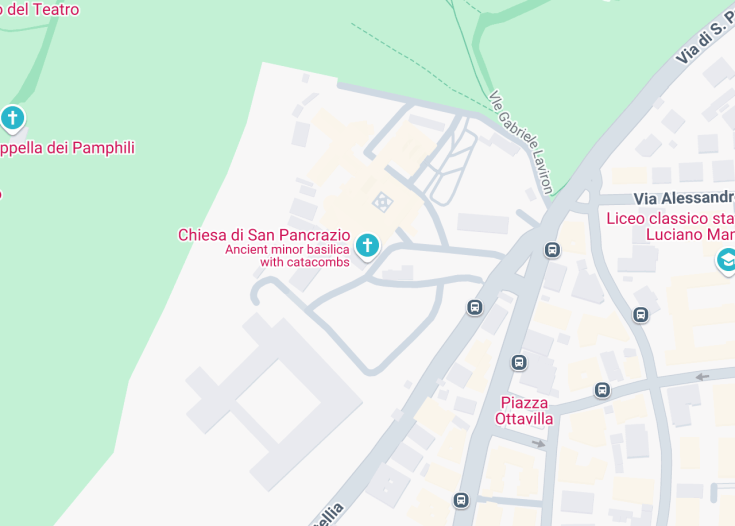The Basilica di San Pancrazio, one of the lesser-known minor basilicas of Rome, is steeped in history and religious significance. Established in the early fifth century by Pope Simplicius on the site of the martyrdom of Saint Pancras, it stands as a testament to early Christian devotion. The church, located on the Gianicolo hill, not only serves as a site of worship but also as a place of historical interest, offering insights into the rich tapestry of Christian heritage in Italy.
Visitors to the Basilica di San Pancrazio are encouraged to explore the tranquil surroundings of Villa Doria Pamphilj nearby. This expansive park provides a serene escape and complements the spiritual atmosphere of the basilica, making it ideal for contemplation.
Planning a visit? Consider timing your exploration to coincide with one of the special liturgical events, which can enhance your experience. Additionally, access to the catacombs is highly recommended for those interested in early Christian practices and the history of martyrdom.
Basilica di San Pancrazio in Rome, Italy
The Basilica di San Pancrazio is a significant minor basilica situated on the Gianicolo hill, notable for its rich historical and architectural heritage. Originally constructed under the orders of Pope Simmaco in the 5th century, the basilica commemorates the martyr San Pancrazio, who died at approximately 14 during the persecution against Christians ordered by Emperor Diocletian. The structure was designed to house his tomb, which was positioned beneath the altar, emphasizing the sacred nature of the site. The basilica exemplifies early Christian architecture with its medieval frescoes, particularly attributed to Antonio Tempesta, adorning the apse’s tribune. The basilica is also characterized by the presence of catacombs, which served as burial sites for early Christians. These underground chambers illustrate the struggles of the period, as Christians navigated persecution while maintaining their faith traditions. In the 7th century, Pope Honorius I undertook a complete reconstruction of the structure, further solidifying its religious significance. The basilica became a focal point for veneration, prompting Pope Gregory I to establish an adjacent monastery for the Benedictine monks to ensure liturgical continuity. This evolution over centuries manifests both in architectural developments and ecclesiastical importance, as evidenced by its designation as a cardinal title in the modern church. The establishment of the parish in 1931 reflected the ongoing relevance of the basilica within the Catholic community, which continues today, as evidenced by visits from popes and controlled public access to its historical sites.
History
5th Century
The initial construction of the Basilica di San Pancrazio began in the early 5th century under Pope Simmaco. It was erected on the site where the young martyr had been buried, symbolizing the early Christian commitment to memorializing their saints and promoting martyrdom as a crucial aspect of faith.
7th Century
By the first half of the 7th century, significant renovations were undertaken during the papacy of Honorius I. The basilica was completely rebuilt, with a focus on placing San Pancrazio’s tomb directly beneath the main altar, thus enhancing its liturgical significance and solidifying its role as a central place of worship for early Christians.
20th Century
On April 12, 1931, the basilica was officially designated as a parish by Pope Pio XI through the *Pastorale munus* bulle. This acknowledgment underscored its ongoing importance within the ecclesiastical hierarchy, allowing the basilica to serve the spiritual needs of the local community while continuing its historical legacy as a site of pilgrimage and reflection.
Visiting the Basilica di San Pancrazio
Visitors to the Basilica di San Pancrazio can explore its historic architectural elements and serene atmosphere. Engaging with the catacombs offers a unique insight into the burial practices of early Christians and their reverence for martyrs. The peaceful gardens surrounding the basilica also provide a contemplative space for reflection and prayer amidst the bustle of Rome.
Rich Heritage of San Pancrazio
The Basilica di San Pancrazio is not only a site of martyrdom but also a reflection of the cultural evolution of early Christian worship. The placement of the martyr’s tomb directly underneath the altar epitomizes the church’s veneration of saints and the significance of Eucharistic celebrations in its liturgy. This tradition resonates through the ages, making the basilica a vital pilgrimage destination.
General informations
Location
The Basilica di San Pancrazio is situated on the Gianicolo hill in Rome, near the scenic Villa Doria Pamphilj, a popular park. This location offers peaceful surroundings away from the bustling city, making it an ideal spot for reflection and exploration.
Address:
Piazza di S. Pancrazio, 5D, 00152 Roma RM, ItalyVisiting Information
The ancient basilica welcomes visitors throughout the week, allowing for a serene visit. The best time to explore the Basilica di San Pancrazio is during the morning hours, when the light illuminates its stunning interior, creating an inviting atmosphere for reflection.
How to reach Basilica di San Pancrazio
Car
Basilica di San Pancrazio can be easily reached by car, with parking available nearby for a nominal fee. Various parking lots are situated along ample routes leading to the basilica.
| Route | Distance | Travel time |
|---|---|---|
| From Termini Station | 5 miles (8 Km) | 20 minutes |
| From Vatican City | 1.5 miles (2.4 Km) | 10 minutes |
| From Piazza Navona | 2 miles (3.2 Km) | 15 minutes |
Public Transport
The basilica can also be conveniently accessed via public transport. The nearest bus stop is within a short walking distance, allowing for a straightforward journey from various parts of the city.
Accessibility and Limitations
While the Basilica di San Pancrazio is generally accessible to visitors, there may be some restrictions, especially concerning the catacombs.
Accessibility
Limitations
- Guided tours are recommended for deeper insights, as self-guided exploration may limit understanding of the basilica’s significance.
- Photography may be restricted in certain areas, especially during services.
- Large bags and backpacks are not permitted inside the basilica for security reasons.
Notes to visitors
- It’s advisable to maintain a respectful atmosphere as many guests come for spiritual reflection.
- Check the parish website for any special events or services that might affect visiting hours.
Common questions
What are the architectural features of Basilica di San Pancrazio?
The Basilica di San Pancrazio showcases a blend of architectural styles that reflect its long history. The basilica features a Romanesque layout, characterized by its simple yet elegant facade and a wide nave flanked by smaller aisles. Inside, the spacious interior is adorned with significant works of art, including frescoes by the painter Antonio Tempesta, particularly visible in the tribune area.
The altar is set directly over the tomb of Saint Pancras, providing a focal point for worshippers. The ceiling exhibits intricate detailing typical of classic Roman basilicas. The surrounding environment is enhanced by the lush greenery of the nearby Villa Doria Pamphilj park, adding to the serene atmosphere of the location.
Visitors will notice the two entrances to the crypts of the catacombs beneath the church. One of these is traditionally linked to the matron Ottavilla, and the second, more accessible entrance leads to the burial site of San Pancrazio himself. These catacombs, while smaller than others in Rome, offer a unique glimpse into early Christian burial practices.
Are there any notable artworks inside Basilica di San Pancrazio?
Yes, the Basilica di San Pancrazio houses several noteworthy artworks that attract visitors’ attention. Among these, the frescoes by Antonio Tempesta are particularly celebrated, decorated in vibrant colors and depicting various religious themes. These artworks contribute significantly to the ambiance of the basilica, reflecting the artistic style prevalent during the period of their creation.
Additionally, the altar features exquisite decorations that enhance its significance, especially since it is positioned over the tomb of Saint Pancras. This positioning not only highlights its importance within the church but also draws attention to the connection between the space and its martyr saint. Visitors may also find various statues and religious iconography strategically placed throughout the interior, reflecting the deep religious heritage of the basilica.
The combination of these artworks and the overall elegance of the architectural features makes the Basilica di San Pancrazio a treasure trove for art lovers and religious pilgrims alike.
What can visitors expect during a visit to Basilica di San Pancrazio?
During a visit to the Basilica di San Pancrazio, visitors can expect a serene and spiritual atmosphere that reflects its status as an important religious site. Upon entering, one is greeted by the expansive nave, complemented by the soft lighting filtering through stained glass that lends a colorful glow to the interior.
Visitors often take time to admire the intricate details of the architecture and the rich artistic contributions, including the striking frescoes by Antonio Tempesta. Many spend moments of reverence at the altar, which holds particular significance as the burial site of Saint Pancras, offering a space for personal reflection or prayer.
The basilica also provides occasional opportunities for guided tours. These tours typically delve into the history and significance of the church and its artworks, offering deeper context for what visitors see. Moreover, the nearby catacombs provide a unique chance to explore early Christian burial sites, adding to the enlightening experience.
Finally, the peaceful surroundings of the basilica, nestled near Villa Doria Pamphilj, provide a perfect location for visitors to enjoy moments of tranquility and beauty in an otherwise bustling city.
Is there a dress code for visiting Basilica di San Pancrazio?
Yes, the Basilica di San Pancrazio, like many religious sites in Rome, has a dress code that visitors are expected to follow. To show respect for the sacred nature of the building, guests should avoid wearing revealing clothing. This means that shorts, skirts above the knee, and sleeveless tops are generally not acceptable attire.
It is recommended that visitors wear clothing that covers the shoulders and knees, which aligns with the traditional dress code observed in most Catholic churches. This practice ensures a respectful atmosphere for worship and contemplation while also adhering to local customs.
Those who arrive dressed inappropriately may be denied entry or asked to cover up. Therefore, it’s wise to plan attire accordingly before visiting the Basilica di San Pancrazio to ensure a smooth and respectful experience while enjoying this historic site.
Are there any unique rituals or events held at Basilica di San Pancrazio?
Basilica di San Pancrazio, given its status as a prominent place of worship, often hosts various rituals and religious events that hold significance in the Catholic liturgical calendar. Regular masses are celebrated here, drawing both locals and visitors looking to participate in the communal aspect of faith.
One of the unique aspects of events at Basilica di San Pancrazio includes the observance of the feast day of Saint Pancras, typically celebrated on May 12. This day often sees special masses, prayers, and gatherings that emphasize the life and martyrdom of the saint, attracting those who have veneration for him.
Additionally, because the basilica is a title of a Cardinal, it may also host significant ecclesiastical events, including those attended by members of the clergy, adding to the solemnity and significance of the rituals performed. Such events contribute not only to the religious experiences of the attendees but also to the cultural and historical richness of the site.

Is the Basilica di San Pancrazio in Rome worth visiting?
The Basilica di San Pancrazio is definitely worth a visit for anyone interested in history and architecture. Located on the scenic Gianicolo hill, this ancient basilica was founded by Pope Simplicius in the 5th century, making it a significant site for those interested in early Christian history. Its serene setting amidst Villa Doria Pamphilj offers a peaceful retreat from the bustling city. Visitors can admire its beautiful frescoes attributed to Antonio Tempesta and the unique catacombs that tell the story of early Christian martyrs. Furthermore, the basilica remains an active place of worship, providing an authentic ambiance. Whether you’re a history buff or simply seeking a tranquil spot, the Basilica di San Pancrazio is a hidden gem that enriches your Roman experience.










